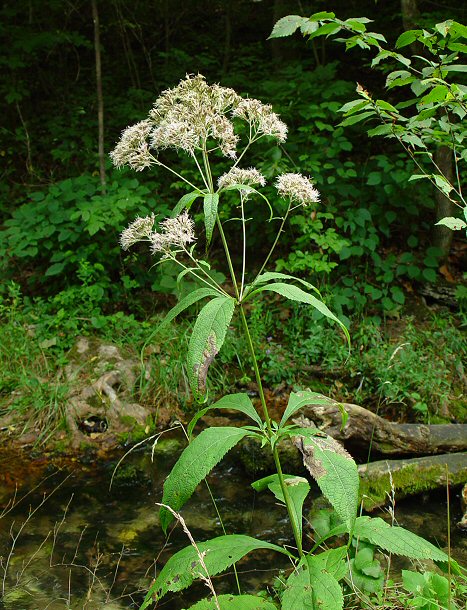Eutrochium purpureum (L.) E.E. Lamont
Green-Stemmed Joe-Pye Weed

Native
CC = 6
CW = 0
MOC = 68
© DETenaglia
Eutrochium purpureum (L.) E.E. LamontGreen-Stemmed Joe-Pye Weed | |
 |
Native CC = 6 CW = 0 MOC = 68 |
© DETenaglia |
|
Family - Asteraceae/Eupatorieae Habit - Perennial forb, fibrous rooted, usually rhizomatous. Stems - Erect, to 2 m, solid or with a slender central cavity toward the base, mostly glabrous below the inflorescence, green with dark purple only at the nodes, not or only slightly glaucous, generally lacking small axillary branches or fascicles of axillary leaves.
Leaves - Whorled, mostly 3 or 4 per node, simple, petiolate. Petioles 2-20 mm long. Blades 5-30 cm long, 25-90 mm wide, narrowly ovate to ovate, elliptic-ovate, or triangular-ovate, tapered at the base, tapered to a sharply pointed tip, the margins sharply toothed, the upper surface glabrous or sparsely to moderately short-hairy, the undersurface glabrous to densely short-hairy, also glandular, with 1 main vein. Teeth with strigillose margins and with prickle tip from vascular tissue extending beyond leaf tissue.
Inflorescences - Terminal panicles, often large, broadly to narrowly dome-shaped. Inflorescence tomentulose, green.
Heads - Discoid. Involucres cylindrical, 6.5-9.0 mm long, slender, the bracts ovate to lanceolate or narrowly oblong-elliptic, bluntly to sharply pointed at the tip, often 3-nerved, usually glabrous, usually purplish-tinged to dark purple. Phyllaries imbricate. Outer phyllaries tomentoulose externally. Innermost phyllaries 8 mm long, 1 mm broad, with scarious margins and few cilia at the apex. Heads with 4-7 florets. Receptacle naked.
Flowers - Ray florets absent. Disc florets 4-7 per head. Corollas 4.5-7.5 mm long, the surface often somewhat glandular, pale pink or somewhat purplish-tinged. Corolla tube 5-6 mm long, 5-lobed, appressed pubescent, lilac. Lobes 0.9 mm long, acute. Stamens 5, adnate about 1/2 way up corolla tube. Anthers whitish-pink, 2 mm long, connate around style. Style bifurcate. Stigmas 5-6 mm long. Pappus of capillary bristles to 6.5 mm long.
Fruits - Achenes 3.0-4.5 mm long, brown or blackish at maturity, angled, glabrous.
Flowering - July - September. Habitat - Bottomland and mesic forests, streambanks, roadsides. Origin - Native to the U.S. Lookalikes - Sometimes, E. maculatum or E. fistulosum, both of which are far less common in Missouri. Other info. - Of the Joe-Pye weeds which occur in Missouri, this species is by far the most common. It occurs across the state, and ranges throughout the eastern half of the continental U.S. and into Canada. It is identified by its whorled leaves and domelike inflorescences of small, whitish to pink or lavender heads. There is some morphological variation and in certain cases the plant can resemble its less common siblings. Useful characters for identification are 4-7 florets per head and stems which are purple only at the nodes. The stems usually have little if any central cavity, and there are usually four leaves per node, though these characters are somewhat variable. Photographs taken at the Kansas City Zoo, 7-23-00 and at Cave Spring, Shannon County, MO., 7-17-03 (DETenaglia); also at Shaw Nature Reserve, Franklin County, MO, 7-23-2011 and 9-4-2011, and at Weldon Spring Conservation Area, St. Charles, MO, 6-27-2012 and 7-29-2014, along the Katy Trail near Treloar, Warren County, MO, 7-4-2020, and at Pacific Palisades Conservation Area, MO, 7-23-2020 (SRTurner); also in St. Louis, 9-10-2020 (KBildner). |